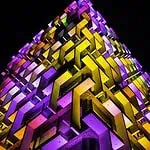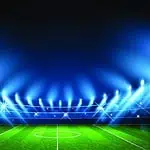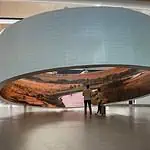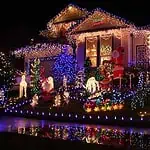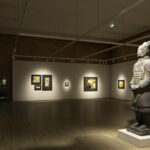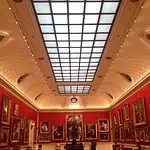Picture yourself sitting in a theater. The lights go down, and suddenly, vibrant colors and stark shadows bring the stage to life. Stage lighting isn’t just about making sure the audience can see the actors. It’s about creating a world, setting a mood, and telling a story without saying a word.
Stage lighting is an essential part of any performance, whether it’s a play, a concert, a dance recital, or a corporate event. It involves the strategic use of light to improve visibility, establish atmosphere, and direct the audience’s attention. Good stage lighting can turn an average performance into an unforgettable experience.
But what exactly is stage lighting? How do different types of lights and lighting techniques contribute to a production? This article will teach you the basics of stage lighting, its primary objectives, and the various parts that make up a stage lighting system. We’ll also cover design principles, practical matters, and advanced techniques so you can light the stage like a pro.
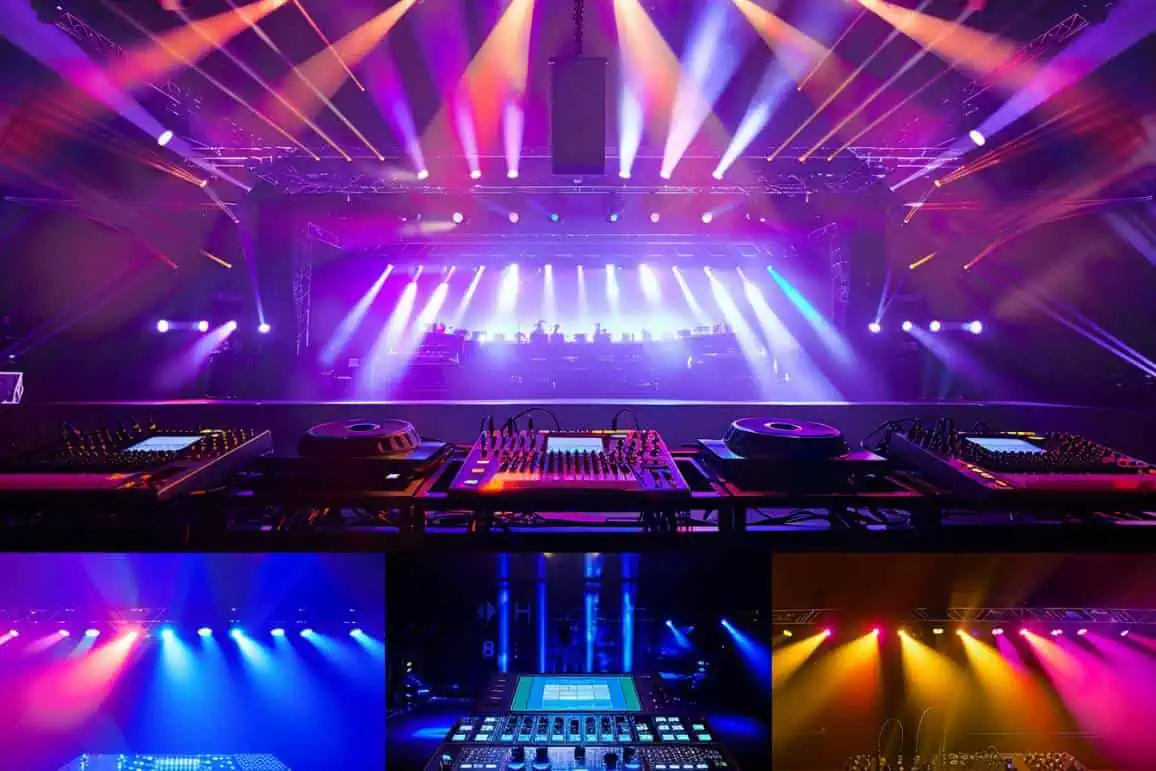
Basics Of Stage Lighting
Understanding Light And Its Properties
When it comes to stage lighting, understanding the fundamental properties of light is crucial. Light isn’t just about how bright it is; it has different characteristics that affect how it interacts with the stage and the performers.
Light Intensity: The brightness of the light. Different parts of a scene may need different levels of brightness to convey the right mood or to focus the audience’s attention on a specific area.
Color: The color of the light can drastically change the mood of a scene. Warm colors like red and orange can make people feel warm or angry. Cool colors like blue and green can make people feel calm or sad.
Direction: The direction from which the light hits an object or a person can change how they look. Light from above can create intense shadows, while light from below can make things look eerie.
Understanding how these characteristics work together makes it easier to create the right atmosphere and make sure the audience’s attention goes where you want it to.
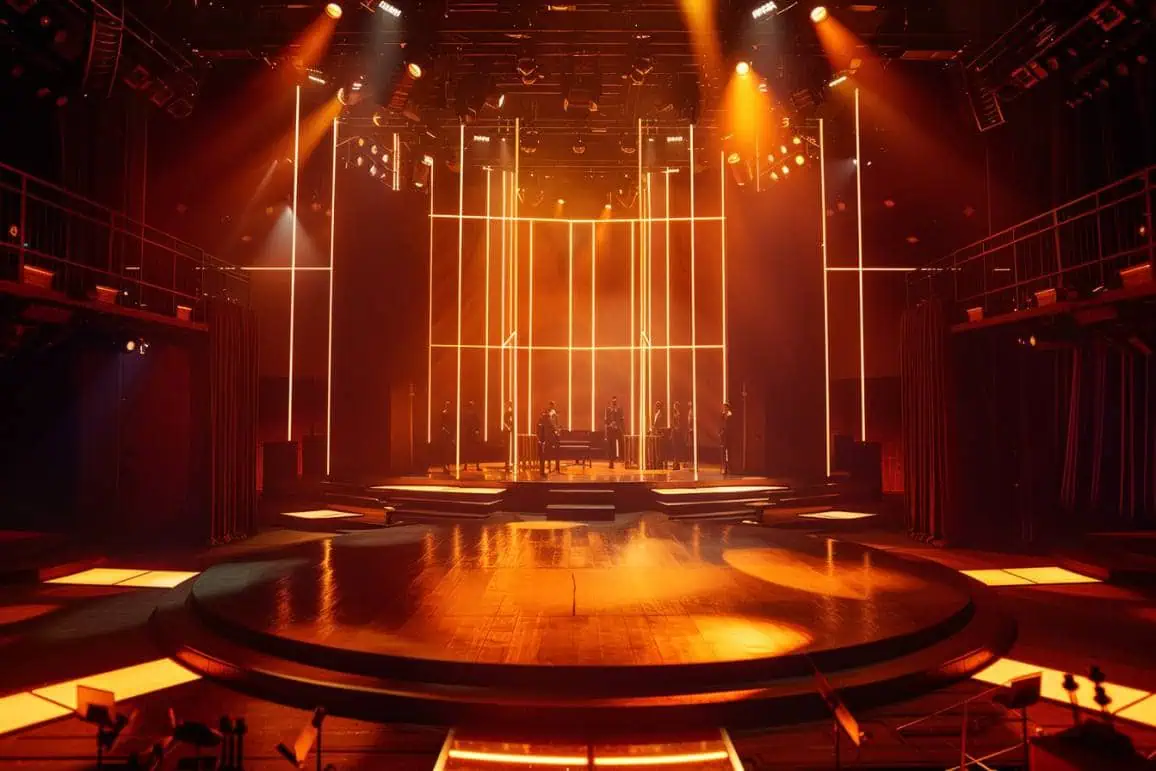
Types Of Light Sources
There are two main categories of light sources used in stage lighting: natural and artificial.
Natural vs. Artificial Light: Natural light, such as sunlight, isn’t typically used in stage lighting because it’s tough to control. Instead, artificial light sources are used because they are controllable and consistent.
Traditional Lighting Fixtures: These include incandescent and halogen lights. Incandescent lights create a warm, natural light but are not energy-efficient. Halogen lights are a type of incandescent light but are slightly more efficient. They produce a brighter, whiter light.
Modern Lighting Fixtures: LEDs and fluorescents are more energy-efficient and versatile. LEDs have become popular in stage lighting because they can change colors and last a long time. Fluorescents are also energy-efficient but are not used as much in stage lighting because they have a tendency to flicker.
Lighting Terminology
To effectively talk about and use stage lighting, you need to know some common terms:
- Lumens: A measurement of the total amount of visible light emitted by a source.
- Watts: A measurement of electrical power consumption.
- Lantern: Another name for a stage light or a lighting fixture.
- Lamps: The actual bulbs used inside lighting fixtures.
- Wash: A broad, even lighting used to cover a large area of the stage.
- Intensity: How bright a light is.
- Diffusion: The scattering of light to create a softer, more even spread.
- Barndoors: Adjustable flaps on the sides of a light fixture that shape the light beam.
- Shutters: Similar to barndoors but typically used in ellipsoidal lights to shape the light more precisely.
- Gel: A colored filter placed in front of a light to change its color.
- Gobo: A template inserted into a light fixture to project shapes or patterns.
- Snoot: A tube that fits over a light to control the direction and spread of the beam.
- Cyclorama (Cyc): A large, often white, curtain or wall used at the back of the stage to create a background.
The Purposes Of Stage Lighting
There are four main purposes of stage lighting, each contributing to the overall impact and effectiveness of the show.
Improved Visibility
At the most basic level, stage lighting makes sure the audience can see what’s happening on stage. Without enough light, the most excellent performance goes unnoticed. Good visibility allows the audience to see the actors’ faces, movements, and the details of the set so they don’t miss anything important.
Setting Mood and Atmosphere
Lighting is a powerful tool for setting the mood and atmosphere of a scene. Different lighting colors and intensities can evoke specific emotions and set the tone of a scene. For example, a dark, dimly lit stage with blue lighting might set a somber, mysterious mood, while bright, warm lighting can make a scene feel happy and inviting.
Directing Audience Attention
Lighting tells the audience where to look. By illuminating key areas or actors on stage, lighting helps direct the audience’s attention to the most important parts of the performance. This is especially crucial in busy scenes with multiple things happening at once.
Advancing The Story
Beyond visibility and mood, lighting can advance the storytelling aspect of a performance. It can help highlight key moments, symbolize themes, or reflect the inner emotions of characters. For example, a sudden shift to red lighting might indicate danger or anger, while a gentle fade to blue might indicate calm or sadness. Lighting design can be as much a part of the story as the script itself.
The Parts Of A Stage Lighting System
A stage lighting system consists of various parts that work together to create the desired effects. Let’s take a look at these parts in detail.
Lighting Fixtures
Lighting fixtures are the instruments that produce the light on stage. Each type has its unique characteristics and uses.
Ellipsoidal (ERS): These are versatile fixtures that produce a narrow beam of light with well-defined edges. They are often used for spotlighting and can be fitted with gobos to project patterns.
Followspot: A manually operated spotlight that follows a performer around the stage. It produces high-intensity light and is perfect for highlighting main characters.
Fresnel: These fixtures produce a soft-edged light, making them ideal for creating general lighting or blending with other lights to provide smooth transitions between different areas.
PAR Can: Short for Parabolic Aluminized Reflector, these lights produce a narrow, intense beam and are commonly used for colored washes and concert lighting.
Floodlight: These provide broad, even illumination and are used for lighting large areas or backgrounds, such as a cyclorama.
Cyc Light: Specifically designed for lighting cycloramas, these fixtures produce even, diffuse light that can be colored to create different backgrounds.
Control Systems
Control systems are used to manage the lighting fixtures and create the desired effects.
Lighting Consoles and Controllers: These are the control panels used by lighting technicians to adjust the intensity, color, and focus of the lights. Modern consoles often have programmable features that allow for complex lighting sequences to be set up and controlled with ease.
DMX Protocol: DMX (Digital Multiplex) is a standard protocol for digital communication networks used to control stage lighting and effects. It allows multiple lighting fixtures to be connected and controlled from a single console, ensuring precise synchronization.
Power Supply and Distribution
A reliable power supply and effective distribution are essential for a smooth lighting operation.
Dimmers and Dimmer Packs: Dimmers control the intensity of the lights by adjusting the voltage supplied to each fixture. Dimmer packs are groups of dimmers housed together, often used in larger installations.
Circuiting and Load Management: Proper circuiting ensures that each lighting fixture receives power without overloading the system. Load management involves distributing the electrical load evenly across circuits to prevent failures and ensure safety.
Design Principles And Techniques
Creating effective stage lighting design is both an art and a science. It requires an understanding of basic principles and the ability to apply various techniques to achieve the desired visual and emotional impact.
Fundamentals Of Lighting Design
Visibility: The primary purpose of stage lighting is to make sure the performers and the set are visible to the audience. However, visibility doesn’t just mean brightness; it means highlighting the right things at the right times to enhance the performance.
Mood: Lighting can evoke specific emotions and set the tone for a scene. Warm colors like reds and yellows can make people feel warm or excited, while cool colors like blues and greens can make people feel calm or sad.
Composition: Lighting helps to compose the visual elements on the stage, guiding the audience’s eye to the most important parts of the scene. It also helps in balancing the overall look, so no part of the stage is disproportionately lit or left in shadow.
Color Theory And Its Application In Lighting:
Monochromatic: Using variations of a single color to create a harmonious look.
Complementary: Combining colors from opposite sides of the color wheel to create contrast and interest. Triads: Using three equally spaced colors on the color wheel for a vibrant and balanced palette.
Adjacent Colors: Using colors next to each other on the color wheel for a harmonious and subtle effect.
Cool Or Warm Colors: Choosing colors based on the desired emotional response, with cool colors often creating a calm or sad atmosphere, and warm colors evoking warmth or excitement.
Lighting Positions And Angles
The position and angle of lighting have a significant impact on the way the stage and the performers are perceived.
Front Lighting: Lights positioned in front of the performers. This is the primary source of visibility and is often used to highlight faces and expressions.
Side Lighting: Lights placed at the sides of the stage. This technique is used to create depth and definition, particularly in dance performances, highlighting the contours of the body.
Back Lighting: Lights positioned behind the performers. This creates silhouettes and adds depth, often used to separate performers from the background and create a sense of space.
Top Lighting: Lights placed above the performers. This can create dramatic shadows and highlights, adding a sense of dimension and drama.
Using Light To Enhance Storytelling
Lighting can be a powerful tool for storytelling, highlighting important moments and characters, and creating atmosphere and mood.
Highlighting Key Moments And Characters: By using spotlights and intense lighting, you can direct the audience’s attention to significant moments or important characters, making sure they are the focal point of the scene.
Creating Atmosphere And Mood: Through the use of color, intensity, and direction, lighting can change the atmosphere on stage. For example, a blue wash can create a sense of calm and serenity, while a red spotlight can add intensity and urgency.
Lighting Instruments And Their Uses
Understanding the different types of lighting instruments and their specific applications is essential for effective stage lighting.
Spotlights and Follow Spots
Features And Applications: Spotlights are powerful, focused lights that produce a sharp, defined beam. They are used to highlight specific areas or performers on stage. Follow spots are a type of spotlight that can be manually operated to follow a performer as they move across the stage. These lights are essential for directing the audience’s attention to key actions or characters, ensuring they remain the focal point even in dynamic scenes.
Floodlights and Wash Lights
Achieving Even Illumination: Floodlights and wash lights are used to provide broad, even lighting over large areas of the stage. Floodlights produce a wide, unfocused beam that evenly lights up a large space, making them ideal for general illumination. Wash lights are similar but can often be adjusted to cover different areas and can be used with gels to add color. These lights are perfect for creating an even base light level, ensuring the entire stage is adequately illuminated.
Fresnel Lanterns
Versatility And Usage In Soft-Edged Lighting: Fresnel lanterns are known for their soft-edged light, making them versatile for various lighting needs. They can be used to create washes of light or to focus on specific areas with a softer transition between light and shadow. The adjustable beam angle of Fresnel lanterns allows for a range of lighting effects, from narrow spots to broad washes, making them invaluable for creating smooth lighting transitions.
PAR Cans and LED Pars
Durability And Color Mixing Capabilities: PAR cans, or Parabolic Aluminized Reflector lights, are durable and versatile fixtures commonly used in stage lighting. They produce an intense, narrow beam of light and are excellent for creating strong color washes. LED PARs offer the added advantage of color mixing capabilities, allowing for a wide range of colors without the need for gels. These fixtures are energy-efficient and have a long lifespan, making them a popular choice for both concerts and theatrical productions.
Intelligent Lighting
Moving Heads And Automated Fixtures: Intelligent lighting fixtures, such as moving heads and automated lights, bring a dynamic element to stage lighting. These lights can move and change color, focus, and patterns during a performance, all controlled by a lighting console. This capability allows for intricate lighting effects and synchronized light shows, adding a high-tech and visually captivating element to productions.
Programming And Control: Intelligent lighting fixtures require programming to function effectively. Lighting designers use consoles to program different scenes, movements, and effects, which can be triggered during the performance. This level of control allows for precise and repeatable lighting cues, enhancing the overall visual experience of the show.
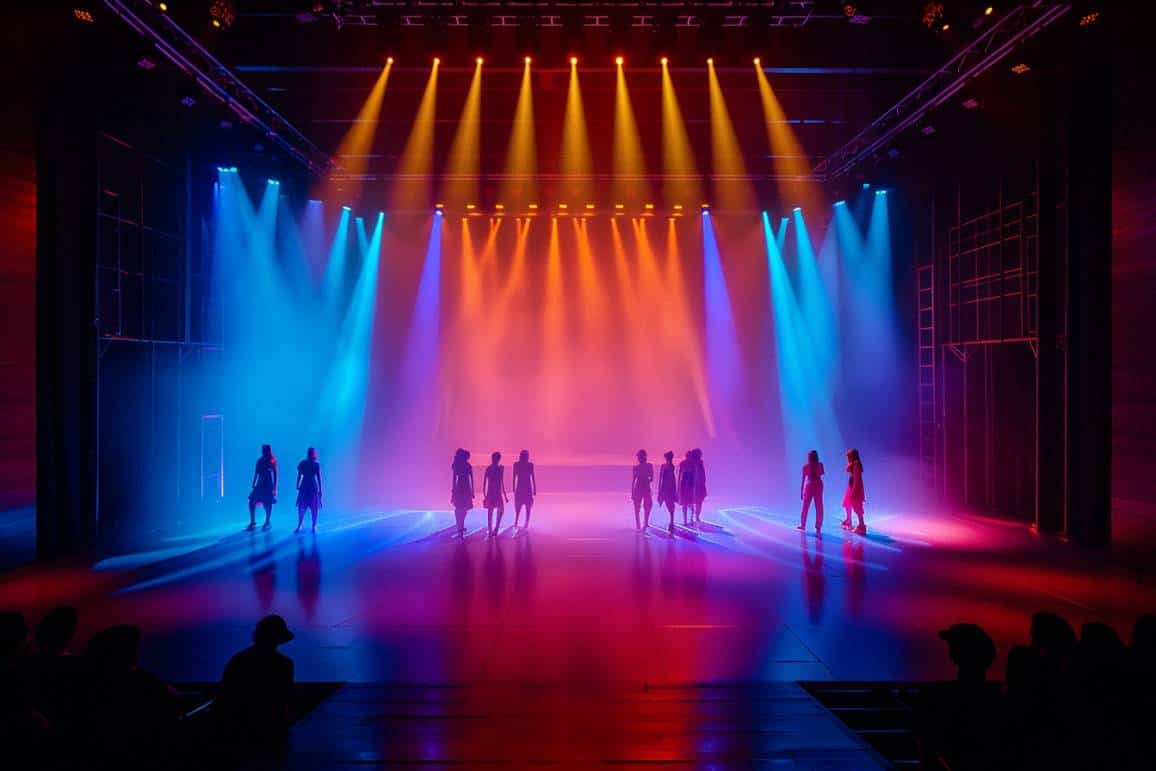
Lighting For Different Types Of Performances
Different performances require tailored lighting techniques to achieve the desired visual and emotional impact. Let’s explore how lighting is used across various types of performances.
Theater Productions
Drama, Musicals, And Comedies: Theater productions rely heavily on lighting to support the narrative and enhance the audience’s emotional experience. In dramas, subtle and focused lighting is often used to highlight intense, emotional moments and character interactions. Musicals tend to use more vibrant and dynamic lighting to match the high-energy performances and musical numbers. Comedies might use bright, even lighting to keep the mood light and the stage clearly visible, emphasizing the comedic timing and expressions of the actors.
Concerts And Live Music
Rock, Pop, Classical, And Other Genres: Concert lighting is designed to complement the music and enhance the live performance experience. Rock and pop concerts often feature dynamic, colorful lighting effects, including strobe lights, moving heads, and lasers, to create a high-energy atmosphere. Classical concerts, on the other hand, might use more refined and understated lighting to match the elegance of the music, focusing on creating a warm, inviting ambiance. Each genre of music can benefit from a unique lighting approach that aligns with its distinct style and audience expectations.
Dance Performances
Ballet, Contemporary, And Other Dance Forms: Dance performances utilize lighting to accentuate movement and create visual depth. Ballet often features soft, ethereal lighting to enhance the graceful movements and delicate costumes of the dancers. Contemporary dance might use more dramatic and contrasting lighting to highlight the physicality and emotional intensity of the performance. Lighting in dance is crucial for emphasizing the form and motion of the dancers, helping to convey the story through their movements.
Corporate Events And Conferences
Keynote Speeches, Product Launches: For corporate events, lighting plays a key role in creating a professional and engaging environment. Keynote speeches benefit from focused lighting on the speaker, ensuring they are clearly visible to the audience. Product launches often use dramatic lighting effects to highlight the new product and create a sense of excitement and anticipation. The goal is to maintain a clean, sophisticated look while ensuring that all important elements are well-lit and visually appealing.
Special Events
Weddings, Parties, And Themed Events: Special events require lighting that enhances the ambiance and complements the theme. Weddings might use soft, romantic lighting to create an intimate atmosphere, with string lights and up-lighting to highlight key areas like the dance floor and tables. Parties can benefit from vibrant, colorful lighting to energize the space and encourage guests to dance and socialize. Themed events often use lighting to reinforce the theme, such as using blue and white lights for a winter wonderland effect or warm, rustic lights for a vintage theme.
Practical Considerations
When planning and executing stage lighting, several practical considerations must be taken into account to ensure a smooth and successful production.
Budgeting and Cost Management
Cost Factors and Budget Planning: Effective budgeting is essential for any stage lighting project. Costs can vary widely depending on the scale of the production, the types of lighting fixtures used, and the complexity of the design. Factors to consider include the purchase or rental of lighting equipment, the cost of electricity, labor for setup and operation, and any additional costs for special effects or advanced lighting technology. Careful planning and allocation of resources are crucial to ensure that the lighting design can be achieved within the available budget.
Safety and Regulations
Electrical Safety and Rigging Standards: Safety is paramount in stage lighting. All electrical equipment must be installed and operated according to industry standards to prevent accidents. This includes proper wiring, grounding, and the use of circuit breakers. Rigging lights overhead requires strict adherence to safety protocols to ensure that fixtures are securely mounted and do not pose a risk of falling. Regular inspections and maintenance of equipment help prevent potential hazards and ensure the safety of both performers and crew.
Collaboration and Communication
Working with Directors, Designers, and Technicians: Successful stage lighting requires close collaboration and communication among various team members. Lighting designers need to work closely with directors to understand the vision and mood of the production. They also need to coordinate with set designers, costume designers, and sound technicians to ensure that the lighting complements all other aspects of the performance. Clear communication and a collaborative approach help align everyone’s efforts toward a cohesive and effective production.
Advanced Lighting Techniques
As stage lighting technology advances, so do the techniques and possibilities for creating stunning visual effects. Here are some advanced lighting techniques that can elevate a production.
Special Effects and Projections
Gobos, Projectors, and Mapping: Special effects can add a new dimension to stage lighting. Gobos, which are stencils or templates placed inside or in front of a light source, can project patterns or images onto the stage. Projectors can display moving images or static backdrops, enhancing the storytelling and visual appeal. Projection mapping involves using multiple projectors to create complex, dynamic visuals on irregular surfaces, such as set pieces or the stage floor, creating an immersive environment.
Lighting for Film and TV
Differences from Live Stage Lighting: Lighting for film and TV differs significantly from live stage lighting. It requires more precise control to ensure consistent lighting for the camera, which often captures more detail than the human eye. Film and TV lighting also need to account for the camera’s color balance and exposure settings. Techniques such as three-point lighting, which uses key, fill, and backlights to create depth and dimension, are commonly used in these productions to ensure subjects are well-lit from multiple angles.
Innovative Technologies
Virtual and Augmented Reality in Lighting: Innovative technologies like virtual and augmented reality are beginning to make their way into stage lighting. Virtual reality (VR) can be used in the design phase to create and test lighting setups in a virtual environment, allowing designers to experiment with different looks before implementation. Augmented reality (AR) can enhance live performances by overlaying digital elements onto the real world, creating interactive and dynamic lighting effects that respond to the performers or audience.
Case Studies and Examples
Exploring real-world examples of stage lighting can provide valuable insights and inspiration for lighting designers.
Iconic Stage Lighting Designs
Analysis of Famous Lighting Designs in Theater and Concerts: Several productions are renowned for their exceptional use of stage lighting. For instance, the Broadway musical “Hamilton” uses dynamic lighting to underscore its innovative storytelling and choreography. The use of sharp spotlights, color changes, and strategic shadows helps convey the emotions and themes of each scene. In concerts, Pink Floyd’s “The Wall” tour is legendary for its groundbreaking lighting design, featuring synchronized lights, projections, and pyrotechnics to create an unforgettable visual spectacle. These examples highlight how thoughtful lighting design can enhance the narrative and emotional impact of a performance.
Behind the Scenes
Interviews with Professional Lighting Designers: Understanding the creative process behind successful lighting designs can be incredibly enlightening. Professional lighting designers often approach their work with a blend of technical knowledge and artistic vision. For instance, Natasha Katz, a renowned Broadway lighting designer, emphasizes the importance of collaboration with directors and choreographers to ensure the lighting complements the overall production. She often starts by reading the script and understanding the story’s emotional beats, then translates those into lighting concepts that enhance the narrative. Insights from professionals like Katz reveal the depth of thought and planning that goes into creating effective stage lighting.
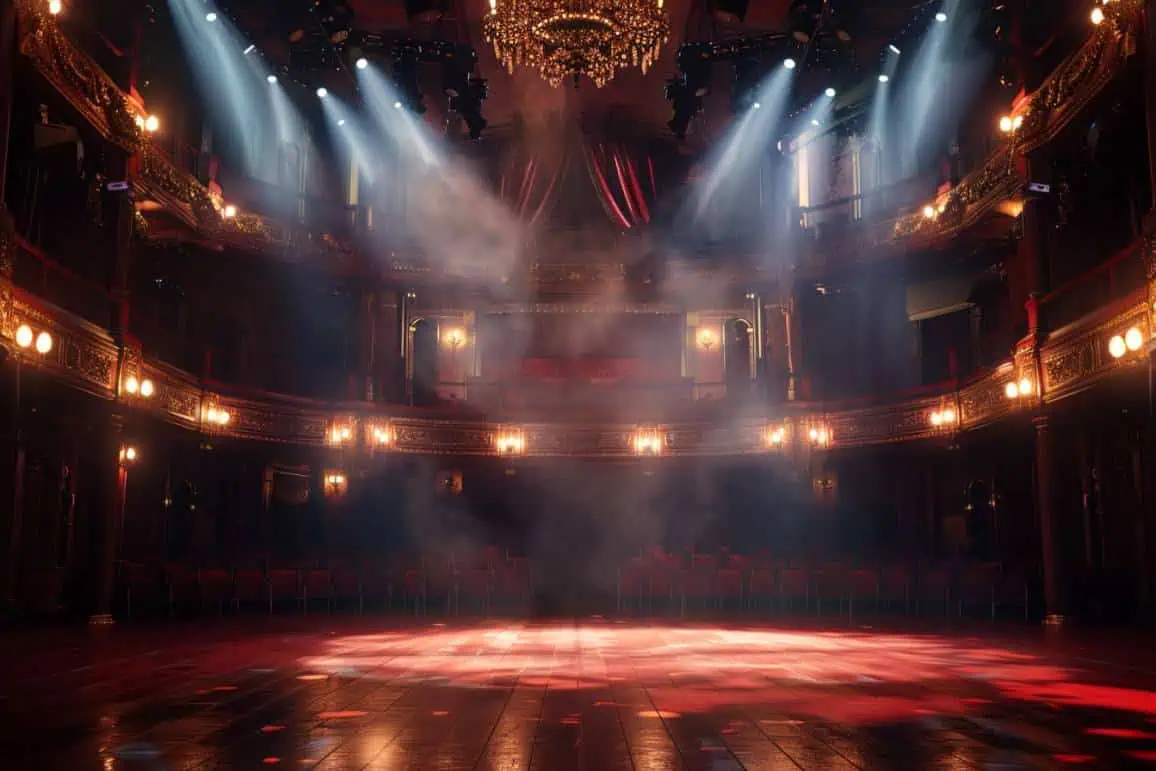
FAQs
A stage lighting system includes lighting fixtures, control systems (like lighting consoles and DMX protocol), and power supply/distribution components such as dimmers and circuiting.
Color theory helps in choosing the right colors to set the mood, create atmosphere, and highlight specific scenes. Techniques like monochromatic, complementary, and triadic color schemes can enhance the visual impact of a performance.
Gobos are stencils or templates placed inside or in front of a light source to project patterns or images onto the stage. They are used to create visual effects and enhance the storytelling aspect of a performance.
Intelligent lighting fixtures, such as moving heads and automated lights, can be programmed to move, change color, and create patterns, offering dynamic and versatile lighting effects that traditional static fixtures cannot achieve.
Ensuring proper electrical safety, secure rigging of lights, regular maintenance, and adhering to industry standards are crucial to prevent accidents and ensure the safety of both performers and crew.
Lighting can evoke emotions and set the tone by using different colors, intensities, and directions. For example, cool colors like blue can create a calm atmosphere, while warm colors like red can evoke excitement or tension.
DMX (Digital Multiplex) is a standard protocol used for digital communication between lighting equipment and controllers. It allows for precise and synchronized control of multiple lighting fixtures from a single console.
Collaboration ensures that the lighting design aligns with the director’s vision and complements other aspects of the production, such as set design, costumes, and sound, creating a cohesive and effective performance.
Common types include ellipsoidal (ERS), followspots, Fresnel lanterns, PAR cans, floodlights, and cyc lights, each serving different purposes like spotlighting, creating washes, and providing general illumination.
Lighting for film and TV requires more precise control to ensure consistency for the camera, taking into account factors like color balance and exposure. Techniques like three-point lighting are commonly used to create depth and dimension on screen.
Conclusion
Stage lighting is an art form that combines technical skill with creative vision. It plays a crucial role in bringing a performance to life, from improving visibility to creating mood and directing the audience’s focus. Understanding the basics of lighting, from the different types of fixtures to the properties of light, is essential for anyone involved in theater or live events.
Furthermore, advanced techniques and innovative technologies continue to expand the possibilities of what can be achieved with stage lighting. By studying iconic lighting designs and learning from industry professionals, aspiring lighting designers can gain the knowledge and inspiration needed to craft their own compelling lighting schemes.
As you delve deeper into the world of stage lighting, remember to experiment and innovate. The right lighting can transform a good performance into an unforgettable one, making every effort to master this craft well worth it.
